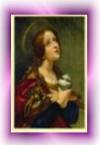After John's death Simeon gave full rein to his ascetical practices and Evagrius declares that he lived only upon the branches of a shrub that grew near Theopolis. Simeon the younger was ordained priest and was thus able to offer the Holy Sacrifice in memory of his mother. On such occasions his disciples one after another climbed up the ladder to receive Communion at his hands. As in the case of most of the other pillar saints a large number of miracles were believed to have been worked by Simeon the Younger. In several instances the cure was effected by pictures representing him (Holl in "Philotesia", 56). Towards the close of his life the saint occupied a column upon a mountain-side near Antioch called from his miracles the "Hill of Wonders", and it was here that he died. Besides the letter mentioned, several writings are attributed to the younger Simeon. A number of these small spiritual tractates were printed by Cozza-Luzi ("Nova PP. Bib.", VIII, iii, Rome, 1871, pp. 4-156). There is also an "Apocalypse" and letters to the Emperors Justinian and Justin II (see fragments in P.G., LXXXVI, pt. II, 3216-20). More especially Simeon was the reputed author of a certain number of liturgical hymns, "Troparis", etc. (see Pétridès in "Echos d'Orient", 1901 and 1902).
Simeon Stylites III, another pillar hermit, who also bore the name Simeon, is honoured by both the Greeks and the Copts. He is hence believed to have lived in the fifth century before the breach which occurred between these Churches. But it must be confessed that very little certain is known of him. He is believed to have been struck by lightning upon his pillar, built near Hegca in Cicilia.
Catholic Encyclopedia

